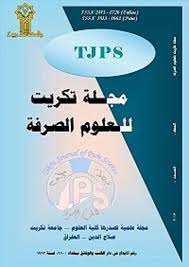Abstract
On bases of immune-haematological and genetic markers ,the genetic variation among Kirkuk indigenous population
was analyzed in this study. In a cross-sectional study of 96 patients with thalassemia intermediate were evaluated by
detailed review that undertaken to define the relationships between ethnic origins, phenotype and immuno-genetic
markers uniformity in relation to genetic isolation and interethnic admixture. All included patients of this study were
subjected to analysis in the hereditary blood diseases centre, including (7(7.2%)) of intermarriages between different
ethnic groups origin, whereas the overall consanguinity marriage rate was estimated at (89 (92.7%)) including
(43(44.7%)) for first cousin marriages origin. Out of the 89 cases, 37(41.5%), 35(39.3%), and 17(19%) represent
Kurdish, Arab and Turkmen ethnic groups, respectively. The distribution of thalassemia major cases within ethnic
groups were relatively differs (d.f.2, P< 0.2). kurdish, (37 (41.5%)) represents the highest disease (thalassemia) sufferer
group because of its relative low rate of out breeding .
Blood groups (ABO) and Rhesus (D) genetic marker show no significant differences among the triethnic sample groups
(thalassemia patients) of Kirkuk with a preponderance of blood group O. No apparent relationship was found between
ABO or Rhesus blood groups and the frequencies of thalassemia intermediate cases.The study showed relative genetic
heterogeneity and diversity with respect to the immuno-hematological genetic markers. Further, all ethnic populations
from Kirkuk were found to harbor thalassemia intermediate genetic marker.Accordingly , all ethnic populations from
Kirkuk were found to harbor thalassemia intermediate genetic marker. However this study shows that ethnic groups of
Kirkuk population have relative genetic heterogeneity and diversity.
was analyzed in this study. In a cross-sectional study of 96 patients with thalassemia intermediate were evaluated by
detailed review that undertaken to define the relationships between ethnic origins, phenotype and immuno-genetic
markers uniformity in relation to genetic isolation and interethnic admixture. All included patients of this study were
subjected to analysis in the hereditary blood diseases centre, including (7(7.2%)) of intermarriages between different
ethnic groups origin, whereas the overall consanguinity marriage rate was estimated at (89 (92.7%)) including
(43(44.7%)) for first cousin marriages origin. Out of the 89 cases, 37(41.5%), 35(39.3%), and 17(19%) represent
Kurdish, Arab and Turkmen ethnic groups, respectively. The distribution of thalassemia major cases within ethnic
groups were relatively differs (d.f.2, P< 0.2). kurdish, (37 (41.5%)) represents the highest disease (thalassemia) sufferer
group because of its relative low rate of out breeding .
Blood groups (ABO) and Rhesus (D) genetic marker show no significant differences among the triethnic sample groups
(thalassemia patients) of Kirkuk with a preponderance of blood group O. No apparent relationship was found between
ABO or Rhesus blood groups and the frequencies of thalassemia intermediate cases.The study showed relative genetic
heterogeneity and diversity with respect to the immuno-hematological genetic markers. Further, all ethnic populations
from Kirkuk were found to harbor thalassemia intermediate genetic marker.Accordingly , all ethnic populations from
Kirkuk were found to harbor thalassemia intermediate genetic marker. However this study shows that ethnic groups of
Kirkuk population have relative genetic heterogeneity and diversity.
